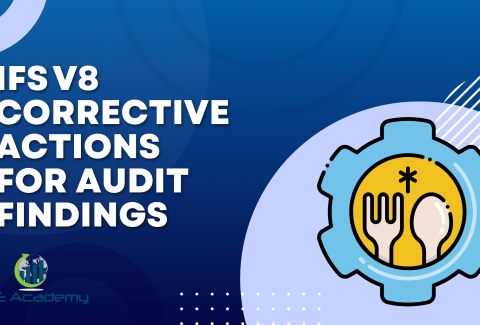IFS V8 Internal‑Audit Checklist Download
Last Updated on November 19, 2025 by Melissa Lazaro
Why an IFS V8 Internal-Audit Checklist Matters
If you’re getting ready for an IFS V8 audit, your internal audit is the closest thing to a rehearsal. In over a decade supporting food manufacturers and processors through IFS, FSSC, and BRCGS readiness, I’ve noticed something consistent: companies that treat internal audits seriously perform significantly better during certification.
Most teams don’t struggle because they don’t know the requirements. They struggle because they’re unsure what to check, how deep to go, and what evidence the auditor will expect.
A structured internal-audit checklist gives you clarity. It helps you find weaknesses early, build consistency, and stay aligned with the new IFS V8 expectations—before a certification body walks in.
Internal Audit Planning — Scope, Frequency, and Competency Requirements
Planning your internal audit correctly sets the tone for the entire process. Under IFS V8, the internal audit must cover the full scope of operations—not just a portion.
Your checklist should include:
- Audit schedule and frequency
- Risk-based prioritization (high-risk areas reviewed more often)
- Assigned auditors and their competency records
- Defined audit criteria and scope
What I’ve seen often is teams create a plan but can’t explain why a specific process is audited once per year versus quarterly. In IFS V8, the reasoning matters.
Pro Tip:
Build the audit plan around process risk—not convenience or calendar logic.
 Documentation and Record Control — SOPs, Forms, and Revision Alignment
Documentation and Record Control — SOPs, Forms, and Revision Alignment
Documentation is one of the most common pressure points in any audit. The goal isn’t just confirming documents exist—it’s confirming they’re current, controlled, and used.
Your checklist should verify:
- Version control
- Authorized approval signatures
- Updated forms at point-of-use
- Records completed correctly and consistently
A client once told me, “We thought documentation was in control until we started auditing it properly.” They found six document versions in circulation—some from three years ago.
Common mistake:
Only reviewing documentation at a desk—never checking whether the same version is being used on the shop floor.
Operational Controls — Hygiene, CCPs, Labeling, and Allergen Management
This part of the internal audit checklist needs to go beyond observation—it should include interviews and record verification.
Checklist focus areas:
- CCP monitoring and corrective action responses
- Hygiene and sanitation controls
- Allergen segregation and label checks
- Foreign-body prevention tools (metal detectors, sieves, filters)
A quick way to measure readiness: ask an operator to explain what, why, and what happens if something goes wrong.
If they can’t, that’s a training and competency gap—not just a documentation gap.
Traceability and Recall Testing — The Internal Stress Test
Traceability failures remain one of the top reasons companies face Majors—or worse.
Your checklist should confirm:
- Raw material → finished product → packaging linkage
- Documentation is complete, accurate, and time-bound
- Recall simulations include time, evidence, and lessons learned
Many companies rehearse recall tests before external audits. But the strongest systems perform unannounced internal simulations—and treat them as learning tools.
Pro Tip:
Include packaging traceability. It’s a frequent weak spot.
Supplier Approval and Incoming Goods — Verifying Control at the Source
Supplier control directly impacts product safety. Internal audits must verify that suppliers are approved, risk-assessed, and monitored.
Checklist items include:
- Supplier approval files complete and current
- Supporting certificates (COA, HACCP, allergen declarations)
- Non-conforming material handling and quarantine procedure
- Inspection and receiving records
One facility failed their audit because they bought packaging from an unapproved supplier—something they discovered only after cross-checking purchases during their internal audit.
Food Safety Culture and Training Effectiveness — Beyond Attendance Sheets
IFS V8 expects organizations to demonstrate food-safety culture—not just talk about it.
Your checklist should confirm:
- Defined culture KPIs and monitoring
- Competency assessments—not just training attendance
- Employee awareness of responsibilities
- Behavior observed matches documented expectations
Interviewing employees during internal audits is the fastest way to uncover gaps you won’t see on paper.
Corrective Actions and Continuous Improvement — Closing the Loop
Finding issues isn’t enough. Internal audits must also verify effectiveness of corrective actions.
Checklist focus:
- Root cause analysis completed and documented
- Corrective action implemented with evidence
- Follow-up and closure with verification
- No recurring pattern from previous audits
One company reduced non-conformities by half after tracking findings by category, not by event. Patterns reveal weaknesses—single events sometimes don’t.
FAQs — Quick Clarifications
Do internal audits need to cover the full scope every year?
Yes—every site, every process, every shift must be included.
Can someone audit their own work?
Not ideally. Internal auditors must be impartial. For small companies, cross-department audits help.
Should internal audits mirror the certification audit format?
Absolutely. Treat it like the real thing.
Conclusion — Final Thoughts and Next Step
A strong internal-audit checklist helps you find issues early, build discipline, and prepare confidently for the IFS V8 audit. It’s not just paperwork—it’s your roadmap to certification success.
If you want the next step, I can turn this into:
- A downloadable Excel audit checklist
- A PDF version for training
- Or a full internal audit program template
Melissa Lavaro is a seasoned ISO consultant and an enthusiastic advocate for quality management standards. With a rich experience in conducting audits and providing consultancy services, Melissa specializes in helping organizations implement and adapt to ISO standards. Her passion for quality management is evident in her hands-on approach and deep understanding of the regulatory frameworks. Melissa’s expertise and energetic commitment make her a sought-after consultant, dedicated to elevating organizational compliance and performance through practical, insightful guidance.








